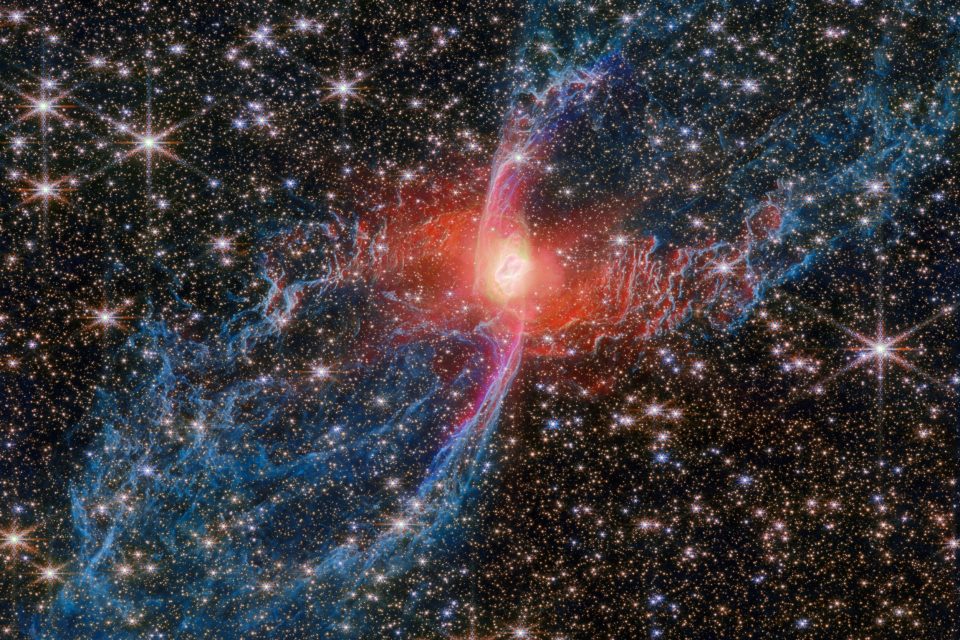Ghostly webs of the Red Spider Nebula revealed
Today’s Image of the Day from the European Space Agency features the Red Spider Nebula, a spectacular cloud of gas and dust that glows like an otherworldly creature drifting through deep space.
Captured by the James Webb Space Telescope, the new image reveals the nebula in striking detail. Every ripple, thread, and arc of gas stands out clearly against a dense backdrop of distant stars.
A dying star’s final act
The Red Spider Nebula, also known as NGC 6537, is located thousands of light-years away in the constellation Sagittarius. It’s what astronomers call a planetary nebula – the final stage in the life of a star roughly the size of our Sun.
When such stars reach the end of their long lives, they swell into red giants, then shed their outer layers into space. What remains is an exposed, blisteringly hot core whose ultraviolet light energizes the surrounding gas, causing it to glow in vivid colors.
This cosmic phase doesn’t last long by astronomical standards – only a few tens of thousands of years – but it’s one of the most beautiful and short-lived transitions a star can make.
The glowing “webs” seen in this image are the remnants of that star’s outer layers, thrown off in waves of gas and dust as it neared its end.
The heart of the Red Spider Nebula
At the center of the nebula, Webb’s Near-Infrared Camera (NIRCam) has revealed something unexpected. In visible-light images from the Hubble Space Telescope, the central star appears faint and bluish.
But in Webb’s near-infrared view, it glows red, wrapped in a shroud of hot dust.That dust likely forms a disc orbiting the star – a structure that may hold clues to how planetary nebulae like this one take shape.
The telescope’s infrared sensitivity has also uncovered subtle textures that had never been seen before.
“The surprising nature of the nebula’s tremendously hot and luminous central star has been revealed by Webb’s NIRCam,” noted ESA.
The new data suggest that the nebula’s shape and energy come not only from this dying star but possibly from the gravitational influence of an unseen partner.
A possible hidden companion
While only one star is visible at the nebula’s core, scientists suspect a second star may be hiding there.
Binary systems – where two stars orbit each other – are thought to sculpt many of the hourglass and butterfly-shaped nebulae seen across the galaxy. The Red Spider’s narrow waist and wide outflows fit that pattern perfectly.
If a companion star does exist, its gravitational tug could explain the nebula’s complex symmetry and the powerful jets streaming from its center.
Similar twin-star shaping has been observed in other planetary nebulae, including the Butterfly Nebula, which Webb has also recently studied in stunning detail.
Giant bubbles and glowing legs
Webb’s new image shows, for the first time, the full reach of the Red Spider’s long lobes – the spider’s “legs.”
These immense bubbles, tinted blue in the image, stretch roughly three light-years from tip to tip. They’re made of molecular hydrogen (H₂), formed when two hydrogen atoms bond together in space.
Over thousands of years, gas flowing from the nebula’s heart has inflated these lobes into closed, bubble-like shapes.
Each bubble is a record of past stellar outbursts, showing where ejected material met resistance in the surrounding gas. The structures capture the story of a dying star’s final breaths, frozen in light and motion.
Even across vast cosmic distances, Webb can trace how these delicate threads connect back to the star that created them.
Jets that shape the cosmic web
The nebula’s core is far from quiet. Webb’s NIRCam has spotted a jet of high-speed gas slicing through the nebula’s heart, leaving behind a faint, elongated purple “S” shape.
This feature, produced by light from ionized iron atoms, marks the path of a fast-moving jet colliding with older material expelled from the star.
Each impact sends shockwaves rippling through the nebula, sculpting its distinctive lobes and filaments.
Over time, such interactions can create complex shapes and glowing knots of gas, showing how even the calmest-looking structures in space are the result of chaotic, energetic forces.
A story of transformation
Seen through Webb’s eyes, the Red Spider Nebula is both haunting and magnificent – a portrait of death giving way to rebirth.
Its vibrant colors and symmetrical arcs hint at the physics of stellar winds, gravity, and light, while its quiet core hides a story of transformation.
What we’re witnessing is the last stage of a once sun-like star, now shedding its layers into space to seed the next generation of cosmic matter.
In a few thousand years, the glow will fade, leaving behind only a white dwarf surrounded by cooling dust. But for now, Webb has captured the Red Spider in its brief moment of brilliance – a fleeting masterpiece in the vast gallery of the universe.
Image Credit: European Space Agency
—–
Like what you read? Subscribe to our newsletter for engaging articles, exclusive content, and the latest updates.Check us out on EarthSnap, a free app brought to you by Eric Ralls and Earth.com.
—–




















